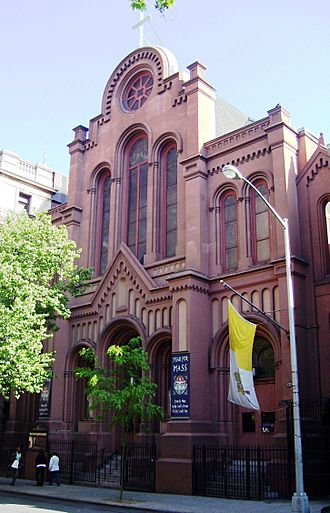Church of Our Lady of the Scapular–St. Stephen facts for kids
Quick facts for kids The Church of Our Lady of the Scapular–St. Stephen |
|
|---|---|

(2011)
|
|
| General information | |
| Architectural style | Romanesque Revival |
| Town or city | Manhattan, New York City |
| Country | U.S. |
| Coordinates | 40°44′33″N 73°58′52.7″W / 40.74250°N 73.981306°W |
| Construction started | school: c.1897 |
| Completed | church: 1854 extension: 1865 school: c.1902 renovation: 1949 rectory: 1954 |
| Client | Roman Catholic Archdiocese of New York |
| Design and construction | |
| Architect | church: James Renwick Jr. extension: Patrick Charles Keely school: Elliott Lynch rectory: Knappe & Johnson |
| Designated | October 28, 2008 |
| Reference no. | 2259 |
The Church of Our Lady of the Scapular–St. Stephen is a Roman Catholic church in Manhattan, New York City. It is located at 149 East 28th Street in the Rose Hill neighborhood. This church was formed in the 1980s. It happened when the parish of Our Lady of the Scapular of Mount Carmel joined with the parish of St. Stephen the Martyr.
In 2007, another church, the Church of the Sacred Hearts of Mary and Jesus, also joined Our Lady of the Scapular–St. Stephen. Later, in 2014, the Archdiocese of New York decided to combine Our Lady of the Scapular–St. Stephen with the Church of Our Saviour.
Contents
History of St. Stephen the Martyr
The St. Stephen the Martyr church community started in 1848. Its first location was on Madison Avenue. A temporary church building was set up and opened in December 1849.
In 1853, the land was bought by a railroad company. So, a new church was built on 28th Street. It opened its doors on March 5, 1854. The first leader of the church was Reverend Jeremiah W. Cummings.
During the 1860s, St. Stephen's was one of the largest and most important Catholic churches in New York. It was known for its sermons and music.
Reverend Cummings passed away in 1866. Reverend Edward McGlynn then became the church leader. Many important people worked at St. Stephen's. These included Charles H. Colton, who later became a Bishop, and Charles Edward McDonnell, who also became a Bishop. In 1877, Henry Gordon Thunder, Sr. became the church's organist and choir director.
Reverend McGlynn was later replaced by Father Colton in 1877. Father Colton started the parish school. In 1903, he became the Bishop of Buffalo. After him, Thomas Francis Cusack led the church from 1904 to 1915. During this time, the church helped the community. It ran a day nursery for children and a place for young working women to live.
In 1988, the Carmelites, a religious group, began to manage the church. In 1990, the Our Lady of the Scapular church community officially joined with St. Stephen the Martyr.
The Church Building of St. Stephen the Martyr
The church building you see today is in the Romanesque Revival style. It was designed by a famous architect named James Renwick Jr.. He also designed other well-known buildings like St. Patrick's Cathedral.
The front of the church has rounded arches for the entrance and windows. In 1865, the building was made longer by architect Patrick Charles Keely.
Inside the church, there are 43 murals, which are large paintings on the walls. These were created by the artist Constantine Brumidi. He also painted murals in the U.S. Capitol building. There is also a painting of the Crucifixion above the main altar by Brumidi. The beautiful stained glass windows were made by Meyer of Munich.
On March 2, 1916, two Spanish poets, Juan Ramón Jiménez and Zenobia Camprubí, got married in this church. Juan Ramón Jiménez later won the Nobel Prize in Literature in 1956. Their time in the United States inspired his important book, Diario de un poeta recién casado (1917).
The church building was repaired and updated in 1949. A school building connected to the church was built around 1902. It was designed by Elliot Lynch. A rectory, which is a house for the priests, was built in 1956. It was designed by the firm Knappe & Johnson.
Since its merger in 2014, this church building is no longer used for regular services.
St. Stephen Parish School
The St. Stephen Parish School on 28th Street was built between 1897 and 1902. It was designed by Elliot Lynch. The Sisters of Charity taught at the school until 1967.
Today, this building is part of the Epiphany School. It is known as the St. Stephen's campus. The Epiphany School has another location on East 20th Street.
Our Lady of the Scapular
The church community of Our Lady of the Scapular of Mount Carmel was started in 1889. It was founded by the Irish Carmelites.


